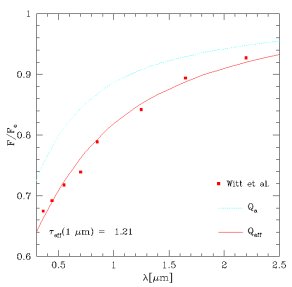
OPTICAL-UV DUST EXTINCTION
In our model we consider a two-phase dusty interstellar medium, a dense one to represent molecular clouds associated with star formation, and a diffuse one associated with older stellar generations. The radiative transfer of starlight through these two dusty media is computed exactly by numerically solving the radiative transfer equation for the dense phase, while we adopt a simplified treatment for the diffuse gas. In this case we ignore dust self-absorption and approximate the effects of optical-UV scattering by means of an effective optical depth, given by the geometrical mean of the absorption and scattering efficiencies: t2eff=ta(ta+ts). The latter approximation is rigorously applicable only to an infinite homogeneus medium and isotropic scattering (see this paper for details).
However we have checked this treatment by comparing our results with those obtained by the Monte Carlo radiative transfer models of dust extinction by (1) Witt, A.N., Thronson, H.A., & Capuano, J.M., 1992, ApJ, 393, 611 (WTC), and (2) Ferrara, A., Bianchi, S., Cimatti, A., Giovanardi, C., astro-ph/9903078 (FBCG), and we find good agreement.
(1) WTC include anisotropic scattering. The plot below shows the ratio F/Fo between the dust extinguished flux and that expected if dust were not present. The points are by WTC, the dotted line is the result of our code taking into account only absorption, whereas the solid line includes scattering with the effective optical depth t2eff=ta(ta+ts). The adopted geometry is that defined by WTC as elliptical galaxy.
(2) We have compared the attenuation curves
computed by FBCG with ours for the case of pure disks (B/T=0,
i.e. the easiest choice in order to best reproduce the same
conditions for the two models) with only the diffuse phase of the
ISM, since this is the one for which these Monte Carlo models
were computed.
See in the three plots below the comparison between the
attenuation curves for the case tV=1 and three values of the ratio zdust/zstar
(the disk scale-heights for diffuse dust and stars), for disks
observed at different inclination angles, but the results are
general and independent of the values assumed for the
aforementioned parameters: the two models almost perfectly agree
for edge-on disks, while we overestimate the attenuation with
respect to FBCG for diminishing inclination angles. The
differences are never higher than ~20-25%, increase for smaller l, and are always ~10% in the V band.